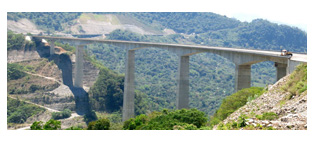
Two new sections of the Mexico City – Tuxpan highway that have just been opened, are equipped with the latest intelligent transportation systems (ITS) and tunnel safety and management equipment. The new 83km (52 miles) sections between Necaxa and Tihuatlán will decrease travel time between the Mexican capital and major tourist destinations on the Gulf of Mexico.
The Spanish multinational, Indra, has designed, set up and deployed the ITS, as well as control and communications systems for the highway’s six tunnels and 10 bridges.
The company has worked as a technology partner of AUNETI (Autopista Necaxa-Tihuatlán), in a joint venture with Spanish construction giant, FCC, on the EUR500m (US$631.5m) project.
A new operational control center in El Piñal manages traffic along the new road’s two sections.
The center is equipped with Indra’s Horus integrated roadway and tunnel management platform that allows centralized control of various systems installed in the new tunnels, which have been designed as per the latest European tunnel directives and guidelines, in order to guarantee maximum security and operation, both in their everyday management, as well as in emergency situations.
Horus integrates all the ITS along the highway, including: closed circuit television (CCTV) systems, traffic meters, road signage, communications, emergency callboxes, fire detection, lighting control, ventilation, and loudspeakers.
The platform will allow operators to monitor the status of the roadway at all times, and have access to real-time information for decision-making purposes.
As part of its EUR14m (US$17.7m) contract, Indra has installed advanced automatic incident detection systems throughout the entire Necaxa-Tihuatlán highway, which enable immediate response to events that could endanger user safety or traffic along the route.
There are several systems for quick implementation of appropriate measures, such as video surveillance systems with automatic incident detection, air quality measurement equipment, fire detection systems, and weather stations, which all trigger alarms in case of an emergency.
The system also includes a network of variable message signs (VMS) that will provide drivers with real-time information regarding road conditions, speed limits and incidents.
Tunnels are also equipped with visibility sensors, an artificial lighting system, an emergency and evacuation system, as well as power generators and backup power systems to address any contingency that may arise.
Source: traffictechnologytoday.com
